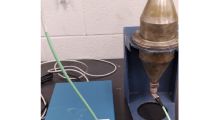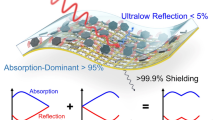Abstract
Absorption-dominant radio-wave (0.2–2.0 GHz) attenuation loss is comparatively reported for materials of high electrical conductivity, namely metals (aluminum and steel) and graphite. These materials exhibit similarly high absorption loss (≤ 91.5%) and similarly low reflection loss (≥ 8.5%), both as fractions of the total loss in dB. The absorption loss is high (< 55 dB) and the reflection loss is low (< 10 dB) for both graphite and the metals. The absorption-dominant attenuation loss of these high-conductivity materials is in contrast to the notion that high conductivity (due to the high impedance mismatch with air) generally causes reflection-dominant attenuation loss. The metals and graphite are in foil form, with the graphite being thicker than the metals. The linear absorption coefficient (directly related to the absorption loss per unit thickness) is lower for graphite (≤ 93 mm−1) than the metals (≤ 394 mm−1), due to the greater thickness of the graphite. The absorption loss and fractional absorption loss contribution increase with increasing frequency, whereas the reflection loss decreases, as consistent with electromagnetic theory. On the other hand, from the viewpoint of the fractional loss in power, reflection dominates over absorption for all three materials in the entire frequency range. For shielding, the metals are more effective than graphite if the absorption loss per unit thickness (< 3400 dB/mm) is considered. For stealth, graphite is advantageous to the metals in the low reflection loss, though it is disadvantageous in the low absorption loss per unit thickness.










Similar content being viewed by others
References
Chung DDL (2020) Materials for electromagnetic interference shielding. Mater Chem Phys 255:123587
Gargama H, Thakur AK, Chaturvedi SK (2016) Polyvinylidene fluoride/nanocrystalline iron composite materials for EMI shielding and absorption applications. J Alloys Compd 654:209–215
Jayalakshmi CG, Inamdar A, Anand A, Kandasubramanian B (2019) Polymer matrix composites as broadband radar absorbing structures for stealth aircrafts. J Appl Polym Sci 136(14):47241
Kong LB, Li ZW, Liu L, Huang R, Abshinova M, Yang ZH, Tang CB, Tan PK, Deng CR, Matitsine S (2013) Recent progress in some composite materials and structures for specific electromagnetic applications. Int Mater Rev 58(4):203–259
De Temmerman L (1992) New metallized materials for EMI/RFI shielding. J Coated Fabr 21:191–198
Li S, Anwar S, Lu W, Hang ZH, Hou B, Shen M, Wang C (2014) Microwave absorptions of ultrathin conductive films and designs of frequency-independent ultrathin absorbers. AIP Adv 4:017130
Obrzut J (2015) Surface conductance and microwave scattering in semicontinuous gold films. ACTA IMEKO 4(3):42–46
Kamchi NE, Belaabed B, Wojkiewicz J, Lamouri S, Lasri T (2013) Hybrid polyaniline/nanomagnetic particles composites: high performance materials for EMI shielding. J Appl Polym Sci 127(6):4426–4432
Uma Varun V, Rajesh Kumar B, Etika KC (2020) Hybrid polymer nanocomposites as EMI shielding materials in the X-band. Mater Today Proc 28:796–798
Iqbal S, Kotnala G, Shah J, Ahmad S (2019) Barium ferrite nanoparticles: a highly effective EMI shielding material. Mater Res Express 6(5):55018
Xi X, Chung DDL (2019) Piezoresistivity and piezoelectricity discovered in aluminum, with relevance to structural self-sensing. Sens Actuators A Phys 289:144–156
Xi X, Chung DDL (2019) Electret, piezoelectret and piezoresistivity discovered in steels, with application to structural self-sensing and structural self-powering. Smart Mater Struct 28(7):075028
Xi X, Chung DDL (2019) Piezoresistivity and piezoelectricity, dielectricity discovered in solder. J Mater Sci Mater Electron 30(5):4462–4472
Xi X, Chung DDL (2019) Effect of nickel coating on the stress-dependent electric permittivity, piezoelectricity and piezoresistivity of carbon fiber, with relevance to stress self-sensing. Carbon 145:401–410
Eddib AA, Chung DDL (2019) Electric permittivity of carbon fiber. Carbon 143:475–480
Xi X, Chung DDL (2019) Colossal electric permittivity discovered in polyacrylonitrile (PAN) based carbon fiber, with comparison of PAN-based and pitch-based carbon fibers. Carbon 145:734–739
Xi X, Chung DDL (2020) Electret behavior of unpoled carbon fiber with and without nickel coating. Carbon 159:122–132
Xi X, Chung DDL (2019) Electret, piezoelectret, dielectricity and piezoresistivity discovered in exfoliated-graphite-based flexible graphite, with applications in mechanical sensing and electric powering. Carbon 150:513–548
Xi X, Chung DDL (2020) Electret behavior of carbon fiber structural composites with carbon and polymer matrices, and its application in self-sensing and self-powering. Carbon 160:361–389
Eddib AA, Chung DDL (2018) First report of capacitance-based self-sensing and in-plane electric permittivity of carbon fiber polymer-matrix composite. Carbon 140:413–427
Xi X, Chung DDL (2019) Capacitance-based self-sensing of flaws and stress in carbon-carbon composite, with reports of the electric permittivity, piezoelectricity and piezoresistivity. Carbon 146: 447–461. Corrigendum to Capacitance-based self-sensing of flaws and stress in carbon-carbon composite, with reports of the electric permittivity, piezoelectricity and piezoresistivity. Carbon (2020) 158: 545
Xi X, Chung DDL (2021) Role of grain boundaries in the dielectric behavior of graphite. Carbon 173:1003–1019
Xi X, Chung DDL (2021) Dynamics of the electric polarization and depolarization of graphite. Carbon 172:83–95
Hong X, Yu W, Chung DDL (2017) Electric permittivity of reduced graphite oxide. Carbon 111:182–190
Hong X, Yu W, Wang A, Chung DDL (2016) Graphite oxide paper as a polarizable electrical conductor in the through-thickness direction. Carbon 109:874–882
Hong X, Yu W, Chung DDL (2017) Significant effect of sorbed water on the electrical and dielectric behavior of graphite oxide. Carbon 119:403–418
Moalleminejad M, Chung DDL (2015) Dielectric constant and electrical conductivity of carbon black as an electrically conductive additive in a manganese-dioxide electrochemical electrode, and their dependence on electrolyte permeation. Carbon 91:76–87
Wang A, Chung DDL (2014) Dielectric and electrical conduction behavior of carbon paste electrochemical electrodes, with decoupling of carbon, electrolyte and interface contributions. Carbon 72:135–151
Hong X, Chung DDL (2015) Exfoliated graphite with relative dielectric constant reaching 360, obtained by exfoliation of acid-intercalated graphite flakes without subsequent removal of the residual acidity. Carbon 91:1–10
Guan H, Chung DDL (2020) Radio-wave electrical conductivity and absorption-dominant interaction with radio wave of exfoliated-graphite-based flexible graphite, with relevance to electromagnetic shielding and antennas. Carbon 157:549–562
Stone G, Puggioni D, Lei S, Gu M, Wang K, Wang Y et al (2019) Atomic and electronic structure of domains walls in a polar metal. Phys Rev B 99(1):014105
Yao H, Wang J, Jin K, Zhang Q, Ren W, Venkatachalam P et al (2019) Multiferroic Metal-PbNb0.12Ti0.88O3-δ films on Nb-doped STO. ACS Appl Electron Mater 1(10):2109–2115
Fei Z, Zhao W, Palomaki TA, Sun B, Miller MK, Zhao Z et al (2018) Ferroelectric switching of a two-dimensional metal. Nature 560(7718):336–339
Kim TH, Puggioni D, Yuan Y, Xie L, Zhou H, Campbell N et al (2016) Polar metals by geometric design. Nature 533(7601):68–72
Zhang H, Deng B, Wang W, Shi X (2018) Parity-breaking in single-element phases: ferroelectric-like elemental polar metals. J Phys 30(41):415504
Zhou WX, Wu HJ, Zhou J, Zeng SW, Li CJ, Li MS (2019) Artificial two-dimensional polar metal by charge transfer to a ferroelectric insulator. Commun Phys 2(1):1–8
Conrad H (2000) Electroplasticity in metals and ceramics. Mater Sci Eng A287(2):276–287
Conrad H (2002) Thermally activated plastic flow of metals and ceramics with an electric field or current. Mater Sci Eng A322(1–2):100–107
Antolovich SD, Conrad H (2004) The effects of electric currents and fields on deformation in metals, ceramics, and ionic materials: an interpretive survey. Mater Manuf Process 19(4):587–610
Andrawes JS, Kronenberger TJ, Perkins TA, Roth JT, Warley RL (2007) Effects of DC current on the mechanical behavior of AlMg1SiCu. Mater Manuf Process 22(1):91–101
Stepanov GV, Babutskii AI, Mameev IA, Olisov AN (2005) Pulse current effect on stress levels in a metal strip in tension. Strength Mater 37(6):593–597
Karpinskii DN, Sannikov SV (2001) Effect of electric current on migration of point defects near a crack tip. J Appl Mech Tech Phys 42(6):1073–1077
Troitskii OA (1969) Electromechanical effect in metals. Pis’ma Zh Eksp Teor Fiz 10(1):18–22
Ugale AD, Jagtap RV, Pawar D, Datar S, Kale SN, Alegaonkar PS (2016) Nano-carbon: preparation, assessment, and applications for NH3 gas sensor and electromagnetic interference shielding. RSC Adv 6(99):97266–97275
Das P, Deoghare AB, Ranjan Maity S (2020) Exploring the potential of graphene as an EMI shielding material: an overview. Mater Today Proc 22:1737–1744
Raagulan K, Kim BM, Chai KY (2020) Recent advancement of electromagnetic interference (EMI) shielding of two Dimensional (2D) MXene and graphene aerogel composites. Nanomaterials 10(4):702
Wan Y, Zhu P, Yu S, Sun R, Wong C, Liao W (2017) Graphene paper for exceptional EMI shielding performance using large-sized graphene oxide sheets and doping strategy. Carbon 122:74–81
Lin S, Ju S, Shi G, Zhang J, He Y, Jiang D (2019) Ultrathin nitrogen-doping graphene films for flexible and stretchable EMI shielding materials. J Mater Sci 54:7165–7179. https://doi.org/10.1007/s10853-019-03372-4
Vovchenko L, Matzui L, Oliynyk V, Launets V, Mamunya Y, Maruzhenko O (2018) Nanocarbon/polyethylene composites with segregated conductive network for electromagnetic interference shielding. Mol Cryst Liquid Cryst 672(1):186–198
The Engineering ToolBox. https://www.engineeringtoolbox.com/permeability-d_1923.html. Accessed 21 July 2019
Material Properties Database. https://www.makeitfrom.com/material-properties/Hot-Rolled-1010-Carbon-Steel. Accessed 4 December 2018
Kittel C (1946) Theory of the dispersion of magnetic permeability in ferromagnetic materials at microwave frequencies. Phys Rev 70(5, 6):281
Luo X, Chung DDL (1996) Electromagnetic interference shielding reaching 130 dB using flexible graphite. Carbon 34(10):1293–1294
Eddib AA, Chung DDL (2017) The importance of the electrical contact between specimen and testing fixture in evaluating the electromagnetic interference shielding effectiveness of carbon materials. Carbon 117:427–436
Eddib AA, Chung DDL (2017) Corrigendum to “The importance of the electrical contact between specimen and testing fixture in evaluating the electromagnetic interference shielding effectiveness of carbon materials”. Carbon 120:337
Hong X, Chung DDL (2017) Carbon nanofiber mats for electromagnetic interference shielding. Carbon 111:529–537
Yan R, Wang K, Wang C, Zhang H, Song Y, Guo Q, Wang J (2016) Synthesis and in-situ functionalization of graphene films through graphite charging in aqueous Fe2(SO4)3. Carbon 107:379–387
Aqeeli M, Leng T, Huang X, Chen JC, Chang KH, Alburaikan A, Hu Z (2015) Electromagnetic interference shielding based on highly flexible and conductive graphene laminate. Electron Lett 51(17):1350–1352
Chung DDL (2016) A review of exfoliated graphite. J Mater Sci 51:554–568. https://doi.org/10.1007/s10853-015-9284-6
Xiao L, Chung DDL (2016) Mechanical energy dissipation modeling of exfoliated graphite based on interfacial friction theory. Carbon 108:291–302
Kaynak A (1996) Electromagnetic shielding effectiveness of galvanostatically synthesized conducting polypyrrole films in the 300–2000 MHz frequency range. Mater Res Bull 31(7):845–860
Author information
Authors and Affiliations
Corresponding author
Ethics declarations
Conflict of interest
The authors declare that they have no conflict of interest.
Additional information
Handling Editor: Kevin Jones.
Publisher's Note
Springer Nature remains neutral with regard to jurisdictional claims in published maps and institutional affiliations.
Rights and permissions
About this article
Cite this article
Guan, H., Chung, D.D.L. Absorption-dominant radio-wave attenuation loss of metals and graphite. J Mater Sci 56, 8037–8047 (2021). https://doi.org/10.1007/s10853-021-05808-2
Received:
Accepted:
Published:
Issue Date:
DOI: https://doi.org/10.1007/s10853-021-05808-2




